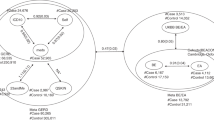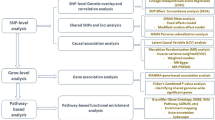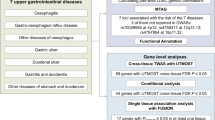Abstract
Gastroesophageal reflux disease (GERD) is a prevalent chronic ailment, and present therapeutic approaches are not always effective. This study aimed to find new drug targets for GERD and Barrett’s esophagus (BE). We obtained genetic instruments for GERD, BE, and 2004 plasma proteins from recently published genome-wide association studies (GWAS), and Mendelian randomization (MR) was employed to explore potential drug targets. We further winnowed down MR-prioritized proteins through replication, reverse causality testing, colocalization analysis, phenotype scanning, and Phenome-wide MR. Furthermore, we constructed a protein-protein interaction network, unveiling potential associations among candidate proteins. Simultaneously, we acquired mRNA expression quantitative trait loci (eQTL) data from another GWAS encompassing four different tissues to identify additional drug targets. Meanwhile, we searched drug databases to evaluate these targets. Under Bonferroni correction (P < 4.8 × 10−5), we identified 11 plasma proteins significantly associated with GERD. Among these, 7 are protective proteins (MSP, GPX1, ERBB3, BT3A3, ANTR2, CCM2, and DECR2), while 4 are detrimental proteins (TMEM106B, DUSP13, C1-INH, and LINGO1). Ultimately, C1-INH and DECR2 successfully passed the screening process and exhibited similar directional causal effects on BE. Further analysis of eQTLs highlighted 4 potential drug targets, including EDEM3, PBX3, MEIS1-AS3, and NME7. The search of drug databases further supported our conclusions. Our study indicated that the plasma proteins C1-INH and DECR2, along with 4 genes (EDEM3, PBX3, MEIS1-AS3, and NME7), may represent potential drug targets for GERD and BE, warranting further investigation.
This is a preview of subscription content, access via your institution
Access options
Subscribe to this journal
Receive 12 print issues and online access
$259.00 per year
only $21.58 per issue
Buy this article
- Purchase on Springer Link
- Instant access to full article PDF
Prices may be subject to local taxes which are calculated during checkout




Similar content being viewed by others
References
Katzka DA, Kahrilas PJ. Advances in the diagnosis and management of gastroesophageal reflux disease. BMJ. 2020;371:m3786.
Richter JE, Rubenstein JH. Presentation and Epidemiology of Gastroesophageal Reflux Disease. Gastroenterology. 2018;154:267–76.
Eusebi LH, Ratnakumaran R, Yuan Y, Solaymani-Dodaran M, Bazzoli F, Ford AC. Global prevalence of, and risk factors for, gastro-oesophageal reflux symptoms: a meta-analysis. Gut. 2018;67:430–40.
Peery AF, Dellon ES, Lund J, Crockett SD, McGowan CE, Bulsiewicz WJ, et al. Burden of gastrointestinal disease in the United States: 2012 update. Gastroenterology. 2012;143:1179–87.e3.
Maret-Ouda J, Markar SR, Lagergren J. Gastroesophageal reflux disease: a review. JAMA. 2020;324:2536–47.
Zheng Z, Shang Y, Wang N, Liu X, Xin C, Yan X, et al. Current advancement on the dynamic mechanism of gastroesophageal reflux disease. Int J Biol Sci. 2021;17:4154–64.
Yadlapati R, DeLay K. Proton Pump Inhibitor-Refractory Gastroesophageal Reflux Disease. Med Clin North Am. 2019;103:15–27.
Nelson MR, Tipney H, Painter JL, Shen J, Nicoletti P, Shen Y, et al. The support of human genetic evidence for approved drug indications. Nat Genet. 2015;47:856–60.
Reay WR, Cairns MJ. Advancing the use of genome-wide association studies for drug repurposing. Nat Rev Genet. 2021;22:658–71.
Ochoa D, Karim M, Ghoussaini M, Hulcoop DG, McDonagh EM, Dunham I. Human genetics evidence supports two-thirds of the 2021 FDA-approved drugs. Nat Rev Drug Discov. 2022;21:551.
Lawlor DA, Harbord RM, Sterne JA, Timpson N, Davey Smith G. Mendelian randomization: using genes as instruments for making causal inferences in epidemiology. Stat Med. 2008;27:1133–63.
Hemani G, Zheng J, Elsworth B, Wade KH, Haberland V, Baird D, et al. The MR-Base platform supports systematic causal inference across the human phenome. Elife. 2018;7:e34408.
Ning Z, Huang Y, Lu H, Zhou Y, Tu T, Ouyang F, et al. Novel Drug Targets for Atrial Fibrillation Identified Through Mendelian Randomization Analysis of the Blood Proteome. Cardiovasc Drugs Ther. 2023. https://doi.org/10.1007/s10557-023-07467-8.
Lin J, Zhou J, Liu Z, Zeng R, Wang L, Li F, et al. Identification of potential drug targets for varicose veins: a Mendelian randomization analysis. Front Cardiovasc Med. 2023;10:1126208.
Gu X, Dou M, Su W, Jiang Z, Duan Q, Cao B, et al. Identifying novel proteins underlying schizophrenia via integrating pQTLs of the plasma, CSF, and brain with GWAS summary data. BMC Med. 2022;20:474.
Ong JS, An J, Han X, Law MH, Nandakumar P, Me Research t. et al. Multitrait genetic association analysis identifies 50 new risk loci for gastro-oesophageal reflux, seven new loci for Barrett’s oesophagus and provides insights into clinical heterogeneity in reflux diagnosis. Gut. 2022;71:1053–61.
Zhang J, Dutta D, Kottgen A, Tin A, Schlosser P, Grams ME, et al. Plasma proteome analyses in individuals of European and African ancestry identify cis-pQTLs and models for proteome-wide association studies. Nat Genet. 2022;54:593–602.
Ferkingstad E, Sulem P, Atlason BA, Sveinbjornsson G, Magnusson MI, Styrmisdottir EL, et al. Large-scale integration of the plasma proteome with genetics and disease. Nat Genet. 2021;53:1712–21.
Pierce BL, Ahsan H, Vanderweele TJ. Power and instrument strength requirements for Mendelian randomization studies using multiple genetic variants. Int J Epidemiol. 2011;40:740–52.
Davies NM, Holmes MV, Davey Smith G. Reading Mendelian randomisation studies: a guide, glossary, and checklist for clinicians. BMJ. 2018;362:k601.
Swerdlow DI, Kuchenbaecker KB, Shah S, Sofat R, Holmes MV, White J, et al. Selecting instruments for Mendelian randomization in the wake of genome-wide association studies. Int J Epidemiol. 2016;45:1600–16.
Deng YT, Ou YN, Wu BS, Yang YX, Jiang Y, Huang YY, et al. Identifying causal genes for depression via integration of the proteome and transcriptome from brain and blood. Mol Psychiatry. 2022;27:2849–57.
Lin J, Zhou J, Xu Y. Potential drug targets for multiple sclerosis identified through Mendelian randomization analysis. Brain. 2023;146:3364–72.
Davey Smith G, Hemani G. Mendelian randomization: genetic anchors for causal inference in epidemiological studies. Hum Mol Genet. 2014;23:R89–98.
Hemani G, Tilling K, Davey Smith G. Orienting the causal relationship between imprecisely measured traits using GWAS summary data. PLoS Genet. 2017;13:e1007081.
Giambartolomei C, Vukcevic D, Schadt EE, Franke L, Hingorani AD, Wallace C, et al. Bayesian test for colocalisation between pairs of genetic association studies using summary statistics. PLoS Genet. 2014;10:e1004383.
Chen L, Peters JE, Prins B, Persyn E, Traylor M, Surendran P, et al. Systematic Mendelian randomization using the human plasma proteome to discover potential therapeutic targets for stroke. Nat Commun. 2022;13:6143.
Kamat MA, Blackshaw JA, Young R, Surendran P, Burgess S, Danesh J, et al. PhenoScanner V2: an expanded tool for searching human genotype-phenotype associations. Bioinformatics. 2019;35:4851–3.
Chong M, Sjaarda J, Pigeyre M, Mohammadi-Shemirani P, Lali R, Shoamanesh A, et al. Novel Drug Targets for Ischemic Stroke Identified Through Mendelian Randomization Analysis of the Blood Proteome. Circulation. 2019;140:819–30.
Elsworth B, Lyon M, Alexander T, Liu Y, Matthews P, Hallett J, et al. The MRC IEU OpenGWAS data infrastructure. bioRxiv. 2020.08.10.244293.
Finan C, Gaulton A, Kruger FA, Lumbers RT, Shah T, Engmann J, et al. The druggable genome and support for target identification and validation in drug development. Sci Transl Med. 2017;9:eaag1166.
Zhou Y, Zhang Y, Lian X, Li F, Wang C, Zhu F, et al. Therapeutic target database update 2022: facilitating drug discovery with enriched comparative data of targeted agents. Nucleic Acids Res. 2022;50:D1398–D407.
Mostafavi S, Ray D, Warde-Farley D, Grouios C, Morris Q. GeneMANIA: a real-time multiple association network integration algorithm for predicting gene function. Genome Biol. 2008;9:S4.
McGowan LM, Davey Smith G, Gaunt TR, Richardson TG. Integrating Mendelian randomization and multiple-trait colocalization to uncover cell-specific inflammatory drivers of autoimmune and atopic disease. Hum Mol Genet. 2019;28:3293–300.
Zheng J, Haberland V, Baird D, Walker V, Haycock PC, Hurle MR, et al. Phenome-wide Mendelian randomization mapping the influence of the plasma proteome on complex diseases. Nat Genet. 2020;52:1122–31.
Lutz SM, Wu AC, Hokanson JE, Vansteelandt S, Lange C. Caution against examining the role of reverse causality in Mendelian Randomization. Genet Epidemiol. 2021;45:445–54.
Zhang Y, Xie J, Wen S, Cao P, Xiao W, Zhu J, et al. Evaluating the causal effect of circulating proteome on the risk of osteoarthritis-related traits. Ann Rheum Dis. 2023;82:1606–17.
Tack J, Pandolfino JE. Pathophysiology of Gastroesophageal Reflux Disease. Gastroenterology. 2018;154:277–88.
Mittal R, Vaezi MF. Esophageal Motility Disorders and Gastroesophageal Reflux Disease. N. Engl J Med. 2020;383:1961–72.
Wouters D, Wagenaar-Bos I, van Ham M, Zeerleder S. C1 inhibitor: just a serine protease inhibitor? New and old considerations on therapeutic applications of C1 inhibitor. Expert Opin Biol Ther. 2008;8:1225–40.
Morgan EL. Modulation of the immune response by anaphylatoxins. Complement. 1986;3:128–36.
Caballero T. Treatment of Hereditary Angioedema. J Investig Allergol Clin Immunol. 2021;31:1–16.
Kavanagh KL, Jornvall H, Persson B, Oppermann U. Medium- and short-chain dehydrogenase/reductase gene and protein families: the SDR superfamily: functional and structural diversity within a family of metabolic and regulatory enzymes. Cell Mol Life Sci. 2008;65:3895–906.
Wanders RJ, Waterham HR. Biochemistry of mammalian peroxisomes revisited. Annu Rev Biochem. 2006;75:295–332.
Kenchaiah S, Evans JC, Levy D, Wilson PW, Benjamin EJ, Larson MG, et al. Obesity and the risk of heart failure. N. Engl J Med. 2002;347:305–13.
Estruch R, Ros E. The role of the Mediterranean diet on weight loss and obesity-related diseases. Rev Endocr Metab Disord. 2020;21:315–27.
Singh S, Sharma AN, Murad MH, Buttar NS, El-Serag HB, Katzka DA, et al. Central adiposity is associated with increased risk of esophageal inflammation, metaplasia, and adenocarcinoma: a systematic review and meta-analysis. Clin Gastroenterol Hepatol. 2013;11:1399–412.e7.
Yu S, Ito S, Wada I, Hosokawa N. ER-resident protein 46 (ERp46) triggers the mannose-trimming activity of ER degradation-enhancing alpha-mannosidase-like protein 3 (EDEM3). J Biol Chem. 2018;293:10663–74.
Xu YX, Peloso GM, Nagai TH, Mizoguchi T, Deik A, Bullock K, et al. EDEM3 Modulates Plasma Triglyceride Level through Its Regulation of LRP1 Expression. iScience. 2020;23:100973.
Bilitou A, Watson J, Gartner A, Ohnuma S. The NM23 family in development. Mol Cell Biochem. 2009;329:17–33.
Acknowledgements
We thank the authors for providing GWAS data and making the GWAS summary data publicly available. We acknowledge the participants and investigators of the ARIC cohort, deCODE cohort, IEU Open GWAS, The Genotype-Tissue Expression Consortium and the study of Ong et al.
Funding
This work was funded by the National Natural Science Foundation of China [grantnumbers82070333]; and the Zhejiang Provincial Natural Science Foundation [grantnumbersLY21H020011].
Author information
Authors and Affiliations
Contributions
Yun-Lu Lin, Tao Yao, and Jia-Feng Lin designed the study and drafted the article; Ying-Wei Wang and Zhi-Xiang Zhou conducted data acquisition, and Ze-Chao Hong, Yu Shen, and Yu Yan performed data analysis and manuscript revision. All authors contributed to the article and approved the submitted version.
Corresponding authors
Ethics declarations
Competing interests
The authors declare no competing interests.
Additional information
Publisher’s note Springer Nature remains neutral with regard to jurisdictional claims in published maps and institutional affiliations.
Supplementary information
Rights and permissions
Springer Nature or its licensor (e.g. a society or other partner) holds exclusive rights to this article under a publishing agreement with the author(s) or other rightsholder(s); author self-archiving of the accepted manuscript version of this article is solely governed by the terms of such publishing agreement and applicable law.
About this article
Cite this article
Lin, YL., Yao, T., Wang, YW. et al. Potential drug targets for gastroesophageal reflux disease and Barrett’s esophagus identified through Mendelian randomization analysis. J Hum Genet (2024). https://doi.org/10.1038/s10038-024-01234-9
Received:
Revised:
Accepted:
Published:
DOI: https://doi.org/10.1038/s10038-024-01234-9



